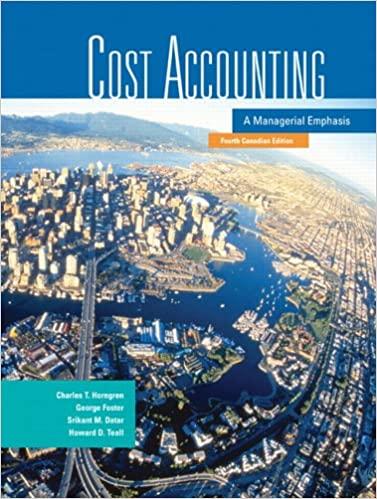ABC, health care. Uppervale Health Centre runs four programs: (1) alcoholic rehabilitation, (2) drug-addict rehabilitation, (3) childrens
Question:
ABC, health care. Uppervale Health Centre runs four programs: (1) alcoholic rehabilitation,
(2) drug-addict rehabilitation, (3) children’s services, and (4) after-care (counselling and sup¬
port of patients after release from a psychiatric hospital).
The centre’s budget for 2007 follows:
Professional salaries:
6 physicians at $120,000 19 psychologists at $60,000 23 nurses at $30,000 Medical supplies General overhead (administrative salaries, rent, utilities, etc.)
$4,440,000
$ 720,000 1,140,000 690,000 $2,550,000 360,000 1,530,000 Mrs. Muriel Clayton, the director ofthe Centre, is keen on determining the cost of each program. She has limited funds and feels that this information will help her to budget better and allocate resources more effectively. For example, Clayton needs to decide whether to allo¬
cate funds to alcoholic rehabilitation or to drug-addict rehabilitation. Her decision rule is that if the cost to treat a drug-addict patient for a year is more than 15% higher than the cost to treat an alcoholic patient for a year, the alcohol program would receive additional funds.
As a first step, Mrs. Clayton, who had earned uniformly high respect from the profes¬
sional staff, asked the staff to fill out a form indicating the time devoted to each of the four programs. She then allocated costs ofmedical supplies based on physician-hours spent in each program and general overhead based on direct-labour cost (where direct labour is defined to include the time of doctors, psychologists, and nurses multiplied by the salary rate of each).
Clayton compiled the following data describing employee allocations to individual programs:
Alcohol Drug Children After-Care Total Employees Physicians 2 4 6 Psychologists 6 4 9 19 Nurses 4 6 4 9 23 Eighty patients are in residence in the alcohol program, each staying about a half-year.
Thus, the clinic provided 40 patient-years of service in the alcohol program. Similarly, 100 patients were involved in the drug program for about a half-year each. Thus die clinic provided 50 patient-years ofservice in the drug program.
Clayton has recently become aware of activity-based costing as a method to refine cost systems. She asks her accountant, Huey Deluth, how she should apply this new technique.
Deluth obtains the following information:
1. Consumption of medical supplies depends on the number of patients in each department and the length oftheir stays (that is, patient-years).
2.General overhead costs consist of Rent and clinic maintenance Administrative costs to manage patient charts, food, laundry Laboratory services Total $ 240,000 960,000 330,000 $1,530,000 3. Other information about individual departments is Alcohol Drug Children After-Care Total Square metres ofspace occupied by each program 9,000 9,000 10,000 12,000 40,000 Patient-years ofservice 40 50 50 60 200 Number of patients 80 100 200 120 500 Number of laboratory tests 400 1,400 3,000 700 5,500 Required 1.
a. Compute indirect-cost rates for medical supplies and general overhead under Clayton’s existing costing system.
b. What is the cost of each program and the cost per patient-year of the alcohol and drug programs, using Clayton’s existing costing system?
c. Using the existing costing system, would Clayton allocate additional funds to the drug program or to the alcohol program?
2.
a. Calculate the indirect-cost rates for medical supplies, rent and clinic maintenance, administrative cost rate for patient charts, food, and laundry, and laboratory services, selecting cost-allocation bases that you believe are the most appropriate for allocating indirect costs to programs.
b. What is the cost of each program and the cost per patient-year of the alcohol and drug programs, using an activity-based costing approach to cost analysis?
c. Using the ABC system, would Clayton allocate additional funds to the drug program or to the alcohol program?
3. Explain the cost differences and the accuracy of program costs calculated using the exist¬
ing and the ABC system. What other benefits can Uppervale Health Centre obtain by implementing the ABC system?
4. What factors, other than cost, do you think Uppervale Health Centre should consider in allocating resources to its programs?
Step by Step Answer:

Cost Accounting A Managerial Emphasis
ISBN: 9780131971905
4th Canadian Edition
Authors: Charles T. Horngren, George Foster, Srikant M. Datar, Howard D. Teall





